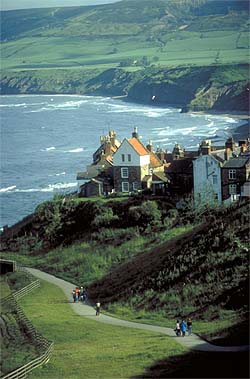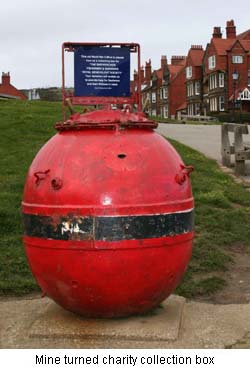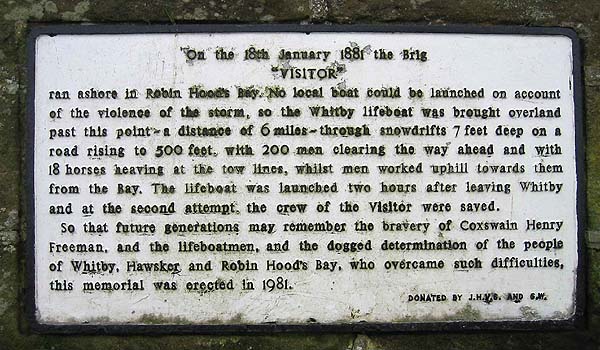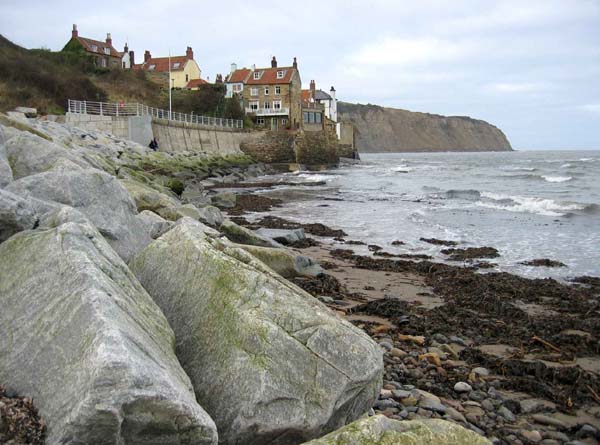Robin Hood's Bay: Fishing Hamlet, Smuggler's Haven
by John Ravenscroft
 Yorkshire people often
call their birthplace "God's Own County" -- and when
you walk the cliff-tops around Robin Hood's Bay in pleasant
weather, when you stop for a moment to take in the spectacular
views and the rugged coastline, you can see why. Yorkshire people often
call their birthplace "God's Own County" -- and when
you walk the cliff-tops around Robin Hood's Bay in pleasant
weather, when you stop for a moment to take in the spectacular
views and the rugged coastline, you can see why.
Robin Hood's Bay isn't just a bay -- it's also a village,
situated about six miles south of Whitby. Taken together, the bay
and the village form part of the beautiful Heritage Coast of the
North Moors National Park.
From the cliff-top car park you can look down over clusters of
red-roofed houses and cottages that give this place an obvious
charm. You'll also notice a large World War II mine (now painted
bright red and impossible to miss) which acts as a collecting box
for The Shipwrecked Fishermen and Mariners Royal Benevolent
Society. This is one of the many indications of the
centuries-long connection between the people of this village and
the sea.
The first reference to Robin Hood's Bay comes in 1538 when it was
recorded as "a fisher townlet of twenty boats". At that
time the settlement consisted of just fifty houses, but from that
day to this the activities of the people living here have centred
around and been dominated by the sea. Generations of fishermen
have lived out their lives here, and smuggling looms large in the
village's history. Many of the houses were once connected by a
network of tunnels -- some still are -- that enabled smuggled
goods to be easily transported from bay to clifftop without ever
seeing the light of day.
In addition to the fishermen and smugglers it has produced over
the years, Robin Hood's Bay also provided the Merchant Navy with
hundreds of new recruits. Records show that in 1750, nearly 300
men out of a population of 800 joined up, and several Navigation
Schools sprang up here to provide them with the skills they
needed.
One of the first questions most visitors want answered when they
arrive at Robin Hood's Bay relates to its name. What connection
does this village have with Robin Hood? After all, he and his
Merry Men were supposed to have done their bit for wealth
redistribution -- robbing the rich and giving to the poor -- not
here on the east coast of Yorkshire, but many miles to the west,
amongst the trees and glades of Sherwood Forest.
The local legend agrees with this, but adds that Robin kept a
collection of getaway boats in the village, just in case the
Sheriff of Nottingham ever made things a little too hot and he
and his Merry Men needed to escape to France.
 Perhaps, but I have my doubts... Perhaps, but I have my doubts...
Robin Hood may not have wandered these streets, but John
Wesley, founder of the Methodist Church, certainly did. He
preached at several locations in the village including Chapel
Street, the Dock and the Square. In King Street, opposite the
Mens' Institute, you can see the writer Leo Walmsley's house.
Walmsley, who lived here from 1894-1913, wrote novels that
revolved around a fictional village he called Bramblewick, a
place that was clearly based on Robin Hood's Bay. His time here
is commemorated with a plaque, and there is further information
about the writer, his novels and his idiosyncratic characters in
the Chapel Book Shop.
Not far from here you'll find the Old Police Station. This
building (now a private house called Beckfield) has an
interesting history.
In the late 1800s, the inhabitants of Robin Hood's Bay were
having some unfortunate social problems. During that period,
gangs of labourers were working on the coastal railway between
Whitby and Scarborough. These were hard-drinking men,
rough-living men, and there were often fights between the
labourers and the locals which resulted in "broken heads
and... helpless drunken legs."
There was no lock-up in Robin Hood's Bay, so those involved in
these fights had to be carted the five miles to Whitby and put in
prison, which was an inconvenient process. It was decided,
therefore, that Robin Hood's Bay needed a prison of its own. This
was built in 1886 at the considerable cost of £1,500. There
were living quarters, an office, two cells and an exercise yard,
but by all accounts the prison doesn't seem to have been
particularly good value for money. According to one Oliver Storm,
a local fisherman, just two prisoners ever stayed overnight. When
a man was actually killed in the battles between labourers and
locals, work on the railway was speeded up and the labourers
moved on to the Whitby-Middlesbrough line, so the prison was no
longer required.
A plaque fixed to a wall near the Collecting-Box Mine tells a
fascinating story of courage and determination. On the 18th of
January, 1881 there was a violent storm, during which a brig
called Visitor ran aground in Robin Hood's Bay. The
weather was so bad it was impossible to launch the local
lifeboat, so a remarkable decision was made. The lifeboat from
Whitby -- six miles away - was taken from its housing and
physically hauled overland. To make the task even more difficult,
there were deep snowdrifts along the route, and at many points
the two hundred men and eighteen horses involved were straining
to pull their burden uphill.

As the Whitby lifeboat inched towards the village, men from Robin
Hood's Bay worked their way up the hillside towards it, clearing
snow with their shovels. It is a testament to the sheer
determination of Yorkshire folk that the lifeboat was launched
just two hours after leaving Whitby, and after one failed attempt
managed to rescue the entire crew of the stranded and
storm-battered Visitor.
The plaque was placed here as a memorial in 1981, exactly one
hundred years after the events it describes.
If you visit Robin Hood's Bay when the tide is out, you can spend
a pleasant hour or two exploring the beach. There are tide pools
worth investigating, fossils to be found beneath your feet, and
all manner of seabirds to keep you company.

If you're feeling energetic, it's possible to walk all the way to
Ravenscar at low tide -- a distance of about three miles -- but
keep a wary eye on the sea. The tide turns swiftly and it's no
fun at all to find you've suddenly been cut off by the incoming
water. Indeed, the main street through the village actually comes
to an end in the sea, and when the tide is particularly high or
the weather is stormy the water surges part-way along it, turning
Robin Hood's Bay into a very different kind of place from the one
you experience on a calm summer's day. The walk from the
sea back to the car park takes the visitor up through the
village's steeply-sloping streets, and can be quite strenuous. If
at the end of that you feel in need of a little refreshment, I
can recommend a meal at The Victoria Hotel. The beer's good, the
food is excellent, and you get an awful lot of it for your
money!
As you might expect given its history and its links with the sea,
Robin Hood's Bay has a thriving Folk Music Club. It meets every
Friday evening in The Dolphin Inn on King Street and its regulars
and guests help to keep the traditional folk singing of the area
alive. It also plays a big part in the Robin Hood's Bay Folk
Weekend, which takes place in June.
In early December the town also hosts an Annual Victorian
Weekend. This is a very popular event, with many visitors joining
the locals in wearing Victorian costumes. Attractions include
Punch and Judy shows, The Grand Turk Choir singing in the Dock,
Professor Fiddlesticks on his unicycle, Morris Dancing and a
Magic Lantern Show!
More Information:
We regret that we no longer have the resources to maintain up-to-date links and/or hours and pricing details for the various sites and attractions listed on this website. For more information about the location(s) listed above, please use your favorite search engine or visit Wikipedia.
John Ravenscroft is a teacher-turned-writer who lives in Lincolnshire, England. He spends much of his time struggling to write fiction and co-editing Cadenza Magazine. His short stories have won prizes in various literary competitions and been published in numerous magazines, and his work has also been broadcast on the BBC. Visit his website at http://www.johnravenscroft.co.uk.
Article © 2006 John Ravenscroft; photos © Astra Ravenscroft
Top photo courtesy of Britainonview.com
| 